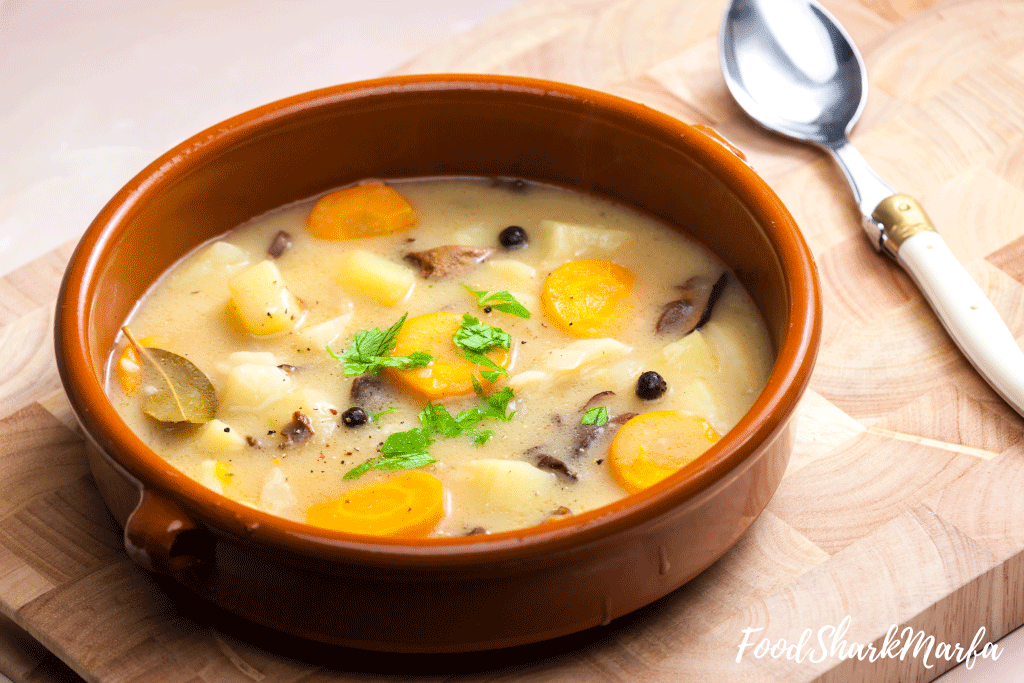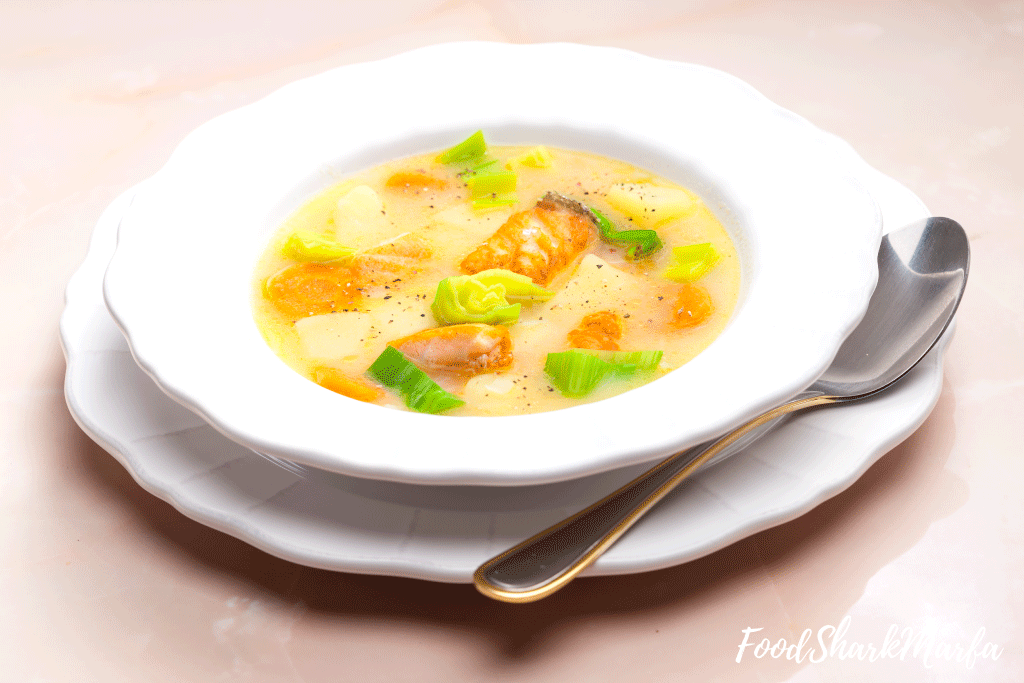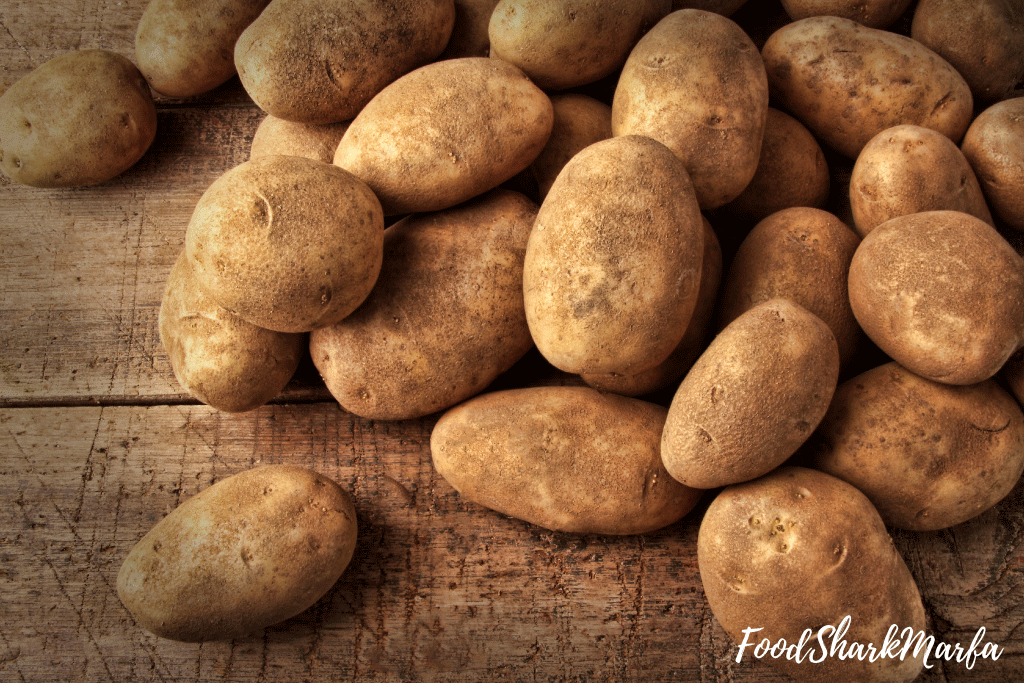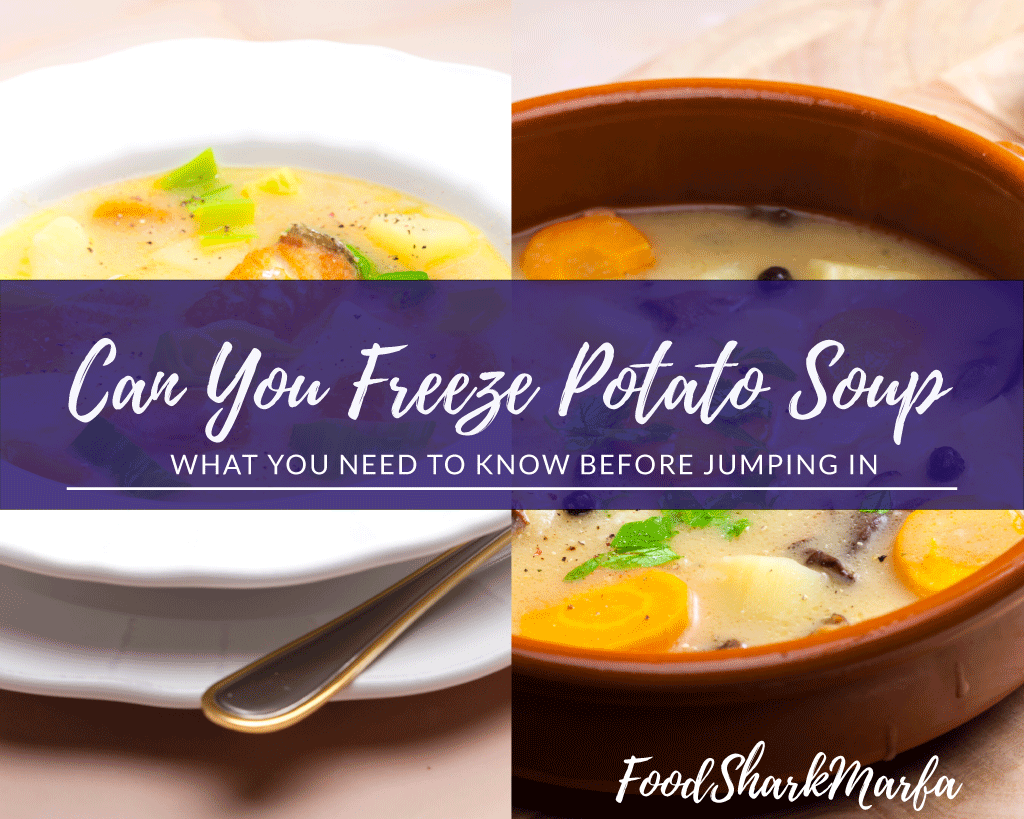As the classic comfort dish, you can rarely go wrong with a bowl of potato soup, whether you prefer your soup creamy, baked or loaded, with bacon or cheese, sour cream or heavy cream, the options for potato soup are virtually endless.

If you have made too much soup, or would just like make a batch for the freezer and have been wondering can you freeze potato soup, the answer is yes, you can freeze potato soup and it should keep for up to six months in the freezer, but, you need to know that the type of potato soup you make, and how you cook the potatoes, will affect the texture more or less once thawed and heated.
In this post, I consider how easy it is to freeze potato soup and just how you should consider freezing it, so it is at its tastiest once thawed.
What Should You Know Before Freezing Potato Soup?
If you prefer your potato soup made with heavy cream, sour cream, cheese or other dairy, you need to know that when cream or cheese is frozen, the fats will separate from the water. Although this does not impair the quality of the soup at all, it does affect its consistency. This means that when you thaw a potato soup containing dairy, it will look like it has curdled.
If you do want to keep some soup for freezing, avoid adding cream or other dairy at the end of cooking, instead, take out the quantity of soup from the pan that you want to freeze and put it to one side to cool. You can then add dairy to what is left in the pan ready for serving up.
If you have frozen soup that contains cream, you will need to give it a good blend after thawing to force the fats and water to recombine and give you a better consistency.
If you have frozen the soup without the dairy then after heating (and blending if required), you can just add the dairy before serving.
It is also worth knowing that non-dairy alternates such as coconut milk or almond milk will not separate as much as dairy so it can be an option to use these in soup, depending of course what type of potato soup you make.
The other thing you need to know when freezing potato soup is that the potatoes themselves can create unappetizing and mushy soup, especially if you cook the potatoes to perfection. This is because potatoes contain a lot of water which naturally expands and forms ice crystals when it freezes. Although we do want small ice crystals to form in frozen foods as they help preserve texture, it is large ice crystals that form in potatoes as they contain a lot of water. These larger ice crystals then rupture the potato’s cells – creating a mushy and soft texture.
There are various options to reduce the risk of mushy potato soup, with making smooth potato soup rather than chunky, being the easiest.
If you want chunky soup, you will only need cook it for around 75% of the usual time, or until the potatoes and other vegetables are al dente. Cutting the veg to a consistent size can also help you to achieve this.
Literally translating as ‘to the tooth’, al dente is far from the almost raw offerings served up in restaurants in the past, instead to cook al dente or tender-crisp, the potatoes and other vegetables in the soup should still have some color, while being heated and cooked through. You should be able to put your teeth or a knife through them easily, but they will still have a slight crunch because they have kept some of their structure.
Once the potatoes are cooked to this point, remove the pan from the heat, take out what quantity you want to use for your meal and place in a separate pan to continue cooking until ready. Leave the remainder in the pan to cool down ready for freezing.
Part cooking the soup means you can thaw and heat it without the potatoes becoming as mushy as they would do if they had been fully cooked.

One note of caution though: if you have added any raw meats to your potato soup, it will need to be fully cooked to a safe internal temperature before cooling for freezing. It is fine if you have added cured or smoked meats such as bacon or ham.
Some prefer to cook potatoes with the skins on and this can help them stay in shape in a chunky soup - just remember to give them a really good scrub before cutting up and cooking. If you do want a smooth soup, it is always better to peel the potatoes as otherwise the skins will leave harder bits in the soup and can also change the color of the finished soup.
The type of potato in the soup can also affect the texture when freezing. Different varieties of potato have differing thickness of skins as well as starch content. As a rule, starchier potatoes do not keep their shape when they cook so are best kept for baking and frying, where fluffiness is important. Lower starch potatoes will hold their shape better in soup and if they are also waxy-skinned, then leaving the skins on in soup will also help keep them firm.

Typical round white or waxy potatoes are low starch and as they hold their shape better after cooking, they are ideal for soup, especially if their skins are left on. Russet or Idaho potatoes are mealier and starchier and although great in baked potato soup, they are best left for mashed potatoes, French fries and of course baked potatoes.
New red potatoes are lower starch potatoes that can be used in the same way as white potatoes and you can leave the waxier skins on for extra color. Fingerling potatoes are also lower starch. These are better left whole – or halved if larger – in broth-based potato soups.
Yukon Gold or yellow potatoes are medium starch potatoes that will not turn to mush as easily so are fine to use in potato soup but do be careful not to overcook them as they will fall apart. Some cooks also suggest that sweet potato will freeze better in soups than white potatoes do.
How Long Will Potato Soup Store in The Refrigerator?
When you have made potato soup, always allow it to cool on the countertop before placing in the refrigerator, but never leave it on the countertop to cool for longer than two hours for food safety.
Potato soup will last as long as five days in the refrigerator but remember its quality and safety will always depend on the shelf life of the ingredients with the shortest shelf life (such as heavy cream).
As with freezing most foods, it’s always sensible to freeze potato soup in portions rather than freezing it all in one large container. Otherwise you will have to use it all after thawing as once thawed, potato soup cannot be refrozen.
How to Freeze Potato Soup
Soup is best frozen in glass containers with storage lids or Ziplock bags. If you prefer to use bags then fill the bag – it can be handy to stand the bag up in a bowl for easier filling – then move the zipper most of the way along the seal before laying it flat on the countertop. You can then push out the remaining air before completely sealing it.
Once you have written the contents and the date on the bag, lay the bags out flat on a cookie sheet at the top of the freezer to allow the soup to freeze solid before moving the bags into the main part of the freezer.
If you freeze the soup in glass containers, either leave an inch of space between the soup and the lid, or as I often do, place the containers on a cookie sheet placed level at the top of the freezer and just sit the lids on top until the soup is frozen. Once frozen, the lids can then be securely fastened on.
If you do not leave space for the soup to expand as it freezes, there is a risk of it shattering the glass and likewise, if you leave too much airspace in the container, then the contents are more likely to suffer freezer burn.
Freezer burn is common in foods not sealed properly in the freezer as exposure to the air causes dehydration on the surface of the food. Ice crystals on the surface of food, along with discoloration or dry spots on meats and fish are the classic signs of freezer burn. Freezer burn does not affect the safety of food, but it can impair its quality and texture and perhaps more importantly, it can affect the nutritional content of the food.
Foods stored in the freezer long term will also develop freezer burn, even if they have been well wrapped. This is why it is important to always write the date on the bag or container when you freeze your potato soup as using it sooner rather than later reduces the risk of freezer burn.
When potato soup in a glass container is taken out to thaw, the lid should also be released to allow air movement as the soup will shrink as the ice in it melts. If not, the lid can be pulled in, making it difficult to remove.
Potato soup should keep at its best for up to six months in the freezer. In many cases it will store for longer but be prepared for it to lose a little of its quality as time goes by.
How Do I Thaw Potato Soup?
The easiest way to thaw potato soup is to place it in the refrigerator the night before you want to eat it. It will then only need a few minutes to heat. If you froze it in a Ziplock bag always defrost in inside a bowl - just in case the bag has been damaged in the freezer.
In case of a dinner emergency, you can pop a Ziplock bag in a bowl of lukewarm water and just keep topping the water up as it cools, or you can take an even quicker approach of thawing and heating it on low heat on the stovetop. Just stir it constantly to prevent it from sticking to the bottom of the pan as it defrosts. Thawing and heating it this way is also ideal if you need to add cream, herbs or other finishing ingredients to it before serving.
A smooth soup straight from the freezer will tolerate microwave heating but you will need to keep opening the door during heating and stirring it to help it heat consistently.
If you have frozen chunky potato soup, it is best to heat (or defrost and heat) in a pan as if you heat a chunky soup from frozen in the microwave, it will often turn mushy. Thawing and heating the soup in a pan is also important if you froze potato soup made with part-cooked potatoes as you may need to leave it simmering a little longer until the veg has a better consistency.
If you are not happy with the consistency or texture of a chunky soup after heating, put it through the blender or use a stick blender to turn it into a smooth soup. It’s easy enough to add a few fresh cooked vegetables for extra texture when you serve it. Some homemade crunchy garlic croutons or toasted seeds will also add extra crunch and texture to it.
When adding cream to the soup, add it at the end of heating. If you are heating on the stovetop, turn down the heat and slowly pour the cream into the soup while stirring it until the cream is fully absorbed and the soup reaches the desired consistency and color. You may want to taste it as you add cream because sometimes a little more seasoning will be necessary.
If the soup is a bit watery and needs thickening, leave it on low heat for a couple of minutes, but do keep stirring to stop it from sticking. Do not let the soup boil as this can cause the cream to curdle.
It is more difficult to thicken a soup with cream when microwaving it, you will need to add the cream and stir well then microwave it in short blasts of 15 or 20 seconds or so, stirring in between each blast until you get the consistency you need.
Otherwise once your potato soup is ready to serve, you can swirl any extra heavy cream or sour cream into it, add your cheese, bacon, chives, croutons, or anything else that you fancy!
Freezing Potato Soup – In Summary
In this post I have shown how you can freeze potato soup successfully. It can be easier to adapt your soup recipe – such as by leaving out the dairy and only part-cooking the potatoes – for more successful freezing, but you can still freeze some of that leftover potato soup – just have the blender at hand to reduce some of the consistency issues when you thaw and heat it.
I hope that you have enjoyed reading all about freezing potato soup and if you have had limited success freezing it previously, that the information and hints contained in here will bring you more success next time you try it.


